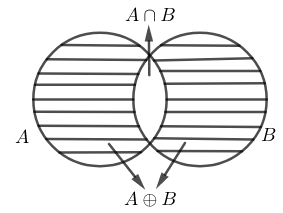
What is the symmetric difference of sets A and B, where A = {1, 4, 9, 10, 15} and B = {2, 4, 7, 10} ?
Answer
516k+ views
Hint: We know that the symmetric difference of two sets, is the set that contains only those elements which are present either in any one of these sets, but not in both of them. We can also find the symmetric difference by subtracting the intersection from the union.
Complete step by step answer:
We know that the symmetric difference of two sets A and B, is the set of elements that contains only those elements which are present either in set A, or in set B, but not in both of them.
In terms of set theory, we can say that the symmetric difference of two sets is the difference of union and intersection of those two sets.
We must also remember that the symmetric difference of set A with respect to set B is represented as $A\oplus B$.
Thus, mathematically, we can also write that
$A\oplus B=A\bigcup B-A\bigcap B$
We can use Venn diagrams to represent the symmetric difference as follows,

Here in this question, we have A = {1, 4, 9, 10, 15} and B = {2, 4, 7, 10}.
We know that the union of two sets is a set containing all elements that are in A or in B.
So, $A\bigcup B$ = {1, 2, 4, 7, 9, 10, 15}.
We also know that the intersection of sets is a set containing all those elements which are present in both A and B.
So, $A\bigcap B$ = {4, 10}.
We know that $A\oplus B=A\bigcup B-A\bigcap B$.
So, $A\oplus B$ = {1, 2, 7, 9, 15}.
Thus, the symmetric difference of sets A and B is {1, 2, 7, 9, 15}.
Note: We must remember that symmetric difference is also known as disjunctive union. We must keep in mind that different texts use different symbols for symmetric difference. Some of these forms are $A\oplus B,A\Delta B\text{ and }A\Theta B$.
Complete step by step answer:
We know that the symmetric difference of two sets A and B, is the set of elements that contains only those elements which are present either in set A, or in set B, but not in both of them.
In terms of set theory, we can say that the symmetric difference of two sets is the difference of union and intersection of those two sets.
We must also remember that the symmetric difference of set A with respect to set B is represented as $A\oplus B$.
Thus, mathematically, we can also write that
$A\oplus B=A\bigcup B-A\bigcap B$
We can use Venn diagrams to represent the symmetric difference as follows,

Here in this question, we have A = {1, 4, 9, 10, 15} and B = {2, 4, 7, 10}.
We know that the union of two sets is a set containing all elements that are in A or in B.
So, $A\bigcup B$ = {1, 2, 4, 7, 9, 10, 15}.
We also know that the intersection of sets is a set containing all those elements which are present in both A and B.
So, $A\bigcap B$ = {4, 10}.
We know that $A\oplus B=A\bigcup B-A\bigcap B$.
So, $A\oplus B$ = {1, 2, 7, 9, 15}.
Thus, the symmetric difference of sets A and B is {1, 2, 7, 9, 15}.
Note: We must remember that symmetric difference is also known as disjunctive union. We must keep in mind that different texts use different symbols for symmetric difference. Some of these forms are $A\oplus B,A\Delta B\text{ and }A\Theta B$.
Recently Updated Pages
Why are manures considered better than fertilizers class 11 biology CBSE

Find the coordinates of the midpoint of the line segment class 11 maths CBSE

Distinguish between static friction limiting friction class 11 physics CBSE

The Chairman of the constituent Assembly was A Jawaharlal class 11 social science CBSE

The first National Commission on Labour NCL submitted class 11 social science CBSE

Number of all subshell of n + l 7 is A 4 B 5 C 6 D class 11 chemistry CBSE

Trending doubts
What is meant by exothermic and endothermic reactions class 11 chemistry CBSE

10 examples of friction in our daily life

One Metric ton is equal to kg A 10000 B 1000 C 100 class 11 physics CBSE

1 Quintal is equal to a 110 kg b 10 kg c 100kg d 1000 class 11 physics CBSE

Difference Between Prokaryotic Cells and Eukaryotic Cells

What are Quantum numbers Explain the quantum number class 11 chemistry CBSE




